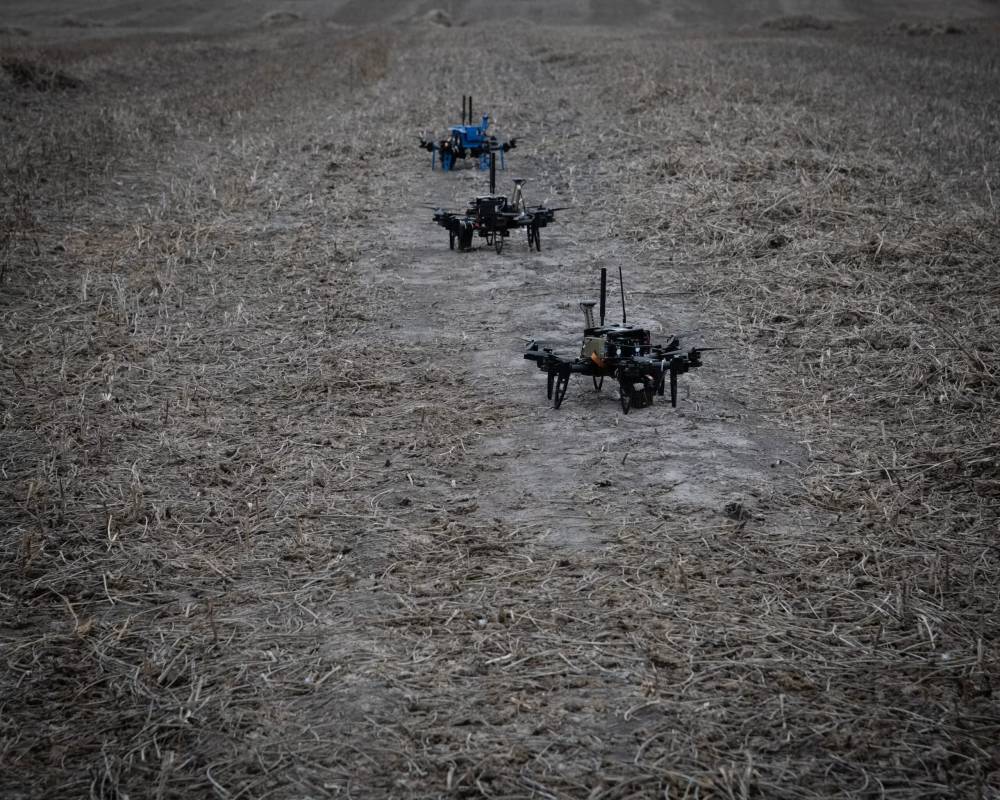
Ukraine tung bầy AI drone vào chiến trường: bước ngoặt nguy hiểm của chiến tranh hiện đại
-
Gần đây, ba UAV Ukraine đã tự phối hợp trong bóng đêm để tấn công một vị trí Nga, quyết định thời điểm ra đòn mà không cần chỉ thị trực tiếp.
-
Đây là minh chứng việc Ukraine đã áp dụng swarm AI – công nghệ cho phép bầy drone giao tiếp, thích ứng và tự đưa ra chiến lược.
-
Swarm AI được xem là bước đột phá, có thể triển khai hàng chục đến hàng nghìn UAV đồng thời để áp đảo phòng thủ đối phương.
-
Ukraine đã sử dụng swarm từ hơn một năm qua, trở thành quốc gia đầu tiên ứng dụng thường xuyên trong chiến đấu.
-
Phần mềm do công ty Ukraine Swarmer phát triển: UAV có thể quyết định drone nào tấn công trước, thay thế khi hết pin, hoặc tự điều chỉnh chiến thuật.
-
Ban đầu công nghệ dùng để rải mìn, sau đó tấn công lính Nga, thiết bị và hạ tầng. Đơn vị Ukraine cho biết đã triển khai hơn 100 nhiệm vụ.
-
Thực tế phổ biến: 1 UAV trinh sát + 2 UAV mang bom tấn công chiến hào Nga. Hệ thống tự quyết định thời điểm và drone nào thả bom.
-
Công nghệ giúp giảm nhân lực: 3 người điều khiển thay vì 9; một phi công có thể kiểm soát nhiều UAV cùng lúc.
-
Ưu thế: giảm nguy cơ Nga gây nhiễu tín hiệu, tăng hiệu quả chiến thuật trong khi Ukraine thiếu nhân lực so với Nga.
-
Swarmer đã thử nghiệm đến 25 UAV, đang chuẩn bị test hơn 100 drone. Đã nhận vốn từ nhà đầu tư Mỹ.
-
Các quốc gia khác như Mỹ, Trung Quốc, Pháp, Nga, Hàn Quốc cũng phát triển swarm AI. Mỹ từng thử nghiệm thả 100 micro-drones năm 2016; Israel đã dùng swarm năm 2021 ở Gaza.
-
Thách thức: kết nối UAV ổn định, chi phí tăng cao (Ukraine đã sản xuất 1,5 triệu UAV trong năm 2024).
-
Vấn đề đạo đức: AI quyết định sinh tử. Liên Hiệp Quốc kêu gọi quản lý vũ khí tự động sát thương. Mỹ và đồng minh vẫn yêu cầu con người giữ quyền quyết định cuối cùng.
📌 Công nghệ bầy drone AI đang thay đổi cán cân chiến tranh: Ukraine tiên phong áp dụng thường xuyên, giảm nhân lực vận hành 3 lần, triển khai hơn 100 nhiệm vụ. Công ty Swarmer thử nghiệm đến 25 UAV và chuẩn bị mở rộng hơn 100 UAV. Ưu thế chiến thuật rõ ràng nhưng chi phí cao và nguy cơ đạo đức lớn: máy móc có thể quyết định sinh tử. Đây là bước ngoặt đưa chiến tranh hiện đại vào kỷ nguyên AI đầy rủi ro.
https://www.wsj.com/world/ai-powered-drone-swarms-have-now-entered-the-battlefield-2cab0f05
AI-Powered Drone Swarms Have Now Entered the Battlefield
In a new frontier for warfare, Ukraine is using technology to allow groups of drones to communicate and make decisions independent of their operator
Three drones on a field during testing.
Swarmer drone technology is tested in Ukraine.
By
Alistair MacDonald
| Photographs by Justyna Mielnikiewicz for WSJ
Sept. 2, 2025 5:36 am ET
On a recent evening, a trio of Ukrainian drones flew under the cover of darkness to a Russian position and decided among themselves exactly when to strike.
The assault was an example of how Ukraine is using artificial intelligence to allow groups of drones to coordinate with each other to attack Russian positions, an innovative technology that heralds the future of battle.
Military experts say the so-called swarm technology represents the next frontier for drone warfare because of its potential to allow tens or even thousands of drones—or swarms—to be deployed at once to overwhelm the defenses of a target, be that a city or an individual military asset.
Ukraine has conducted swarm attacks on the battlefield for much of the past year, according to a senior Ukrainian officer and the company that makes the software. The previously unreported attacks are the first known routine use of swarm technology in combat, analysts say, underscoring Ukraine’s position at the vanguard of drone warfare.
Swarming marries two rising forces in modern warfare: AI and drones. Companies and militaries around the world are racing to develop software that uses AI to link and manage groups of unmanned aerial vehicles, or UAVs, leaving them to communicate and coordinate with each other after launch.
But the use of AI on the battlefield is also raising ethical concerns that machines could be left to decide the fate of combatants and civilians.
The drones deployed in the recent Ukrainian attack used technology developed by local company Swarmer. Its software allows groups of drones to decide which one strikes first and adapt if, for instance, one runs out of battery, said Chief Executive Serhii Kupriienko.
“You set the target and the drones do the rest,” Kupriienko said. “They work together, they adapt.”
Swarmer’s technology was first deployed by Ukrainian forces to lay mines around a year ago. It has since been used to target Russian soldiers, equipment and infrastructure, according to the Ukrainian military officer.
The officer said his drone unit had used Swarmer’s technology more than a hundred times, and that other units also have UAVs equipped with the software. He typically uses the technology with three drones, but says others have deployed it with as many as eight. Kupriienko said the software has been tested with up to 25 drones.
A common operation uses a reconnaissance drone and two other UAVs carrying small bombs to target a Russian trench, the officer said. An operator gives the drones a target zone to look for an enemy position and the command to engage when it is spotted. The reconnaissance drone maps the route for the bombers to follow and the drones themselves then decide when, and which one, will release the bombs over the target.
Three people are involved in these missions: a planner, a drone operator and a navigator. Without the swarm software, nine people would be required, the officer said. Using the technology saves time and frees up personnel to work on other tasks, he added.
“You don’t require a separate pilot for each drone, one pilot can work with many drones,” Kupriienko said.
That is a help for Ukraine, which is fighting an adversary in Russia with far greater manpower. Fewer operators also simplifies coordination, while having drones communicate with each other at proximity reduces the risk that the enemy can interfere with signals to the UAVs.
To be sure, the Ukrainian operations fall short of what many would consider a full swarm, said Bob Tollast, a researcher at the Royal United Services Institute, a U.K.-based think tank. That could be described as hundreds of drones moving together intelligently and autonomously reacting.
Still, “even a small level of autonomous teaming would be impressive,” Tollast said.
Swarmer said it is preparing to test a swarm of more than 100 drones.
The business, which has secured funding from U.S. investors, is one of a number of companies working on swarm technology. On a visit last year to its office, hidden in a suburban house, two young engineers worked on a ping-pong table welding circuit boards and attaching components to drones. Elsewhere, a 3-D printer noisily produced a new component.
Outside, a neighbor mowed his lawn, seemingly oblivious to what was happening next door. Drones are loaded onto vehicles in a garage away from public view.
The U.S., China, France, Russia and South Korea are among the countries pursuing swarm technology. But analysts said they weren’t aware of it being used regularly in combat until hearing of the Ukrainian operations.
The U.S. has been exploring the technology since at least 2016, when it launched more than 100 small drones from three jet fighters. “The micro-drones demonstrated advanced swarm behaviors such as collective decision-making, adaptive formation flying, and self-healing,” the Defense Department said at the time.
Swarmer engineers used a ping-pong table in a suburban house to weld circuit boards and attach components to drones.
In 2021, officials from Israel’s military told local media that it used a swarm of small drones to locate, identify and attack militants in Gaza.
However, the Israeli military doesn’t appear to have talked about swarming since, leading some drone experts to suggest that there may be challenges with its technology. The Israeli military declined to comment.
For all drone swarms, maintaining stable and reliable communication links between the UAVs is likely to be a challenge, said Zak Kallenborn, a drone-warfare expert at King’s College London.
In Ukraine, Swarmer’s technology had teething problems. At one stage, drones were swapping too much information and overloading the network, the Ukrainian officer said.
The technology also makes drones more expensive. That is a negative for Ukraine, which burns through UAVs. The country produced over 1.5 million drones last year alone, the government said.
AI is a growing focus for militaries and is increasingly being used in combat, though mostly to analyze data or navigate.
But the rise of AI in war is raising ethical concerns about the potential for machines to make life-or-death decisions without human oversight. The United Nations has, for example, called for regulation of lethal autonomous weapons.
The U.S. and its allies require a person in the so-called kill chain under current rules of engagement.
Swarmer said a human ultimately makes the decision on whether to pull the trigger.
“Folks have been talking about the potential of drone swarms to change warfare for decades,” said Kallenborn. “But until now, they’ve been more prophecy than reality.”
Thảo luận
Follow Us
Tin phổ biến



